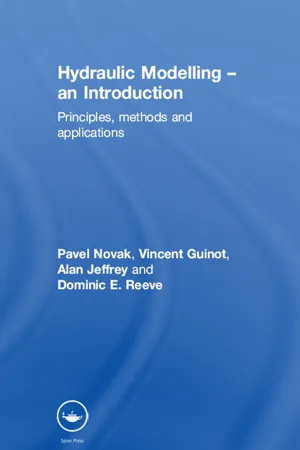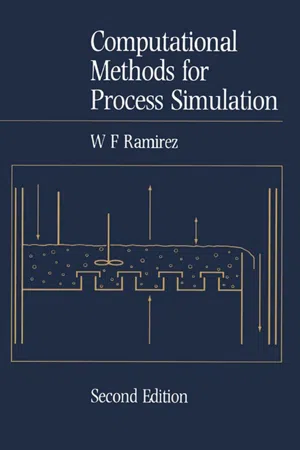General Solution of Differential Equation
The general solution of a differential equation is a family of solutions that includes all possible specific solutions to the equation. It typically contains arbitrary constants that can take on different values, allowing for a wide range of specific solutions. Finding the general solution is important in solving differential equations and understanding the behavior of the system they model.
7 Key excerpts on "General Solution of Differential Equation"
- F. Xavier Malcata(Author)
- 2020(Publication Date)
- Wiley(Publisher)
...15 Solution of Differential Equations Any equation containing differential coefficients is termed differential equation. Such equations can be divided into two major types – ordinary and partial; said classification depends on whether they encompass algebraic operations, lumped in f, on a single independent variable – and thus only ordinary derivatives appear as coefficients, i.e. f { x, y, dy / dx, d 2 y / dx 2, … } = 0, or more than one independent variable – so partial derivatives play the role of independent coefficients, e.g. f { x, y, z, ∂z / ∂x, ∂z / ∂y, ∂ 2 z / ∂x 2, ∂ 2 z / ∂x∂y, ∂ 2 z / ∂y 2, …} = 0 in the bivariate case. When a differential equation contains no terms on its independent variable(s) only, it is said to be homogeneous – otherwise it is labeled as nonhomogeneous; solutions for the latter may often be obtained using the corresponding homogeneous solution as template. The order of a differential equation is the order of the highest differential coefficient contained therein; the degree of a differential equation is the power to which the highest order differential coefficient is raised when the equation is rationalized (i.e. following removal of fractional powers). The general solution of a typical partial differential equation is a combination of arbitrary functions of specific arguments; their exact form is to be determined by application of boundary (and/or initial) conditions – dependent on the nature of the system/process under scrutiny. Conversely, the general solution of an ordinary differential equation contains as many specific independent functions (each one multiplied by an arbitrary constant) as its order. The most common methods of analytical solution, via integration, will be reviewed below. 15.1 Ordinary Differential Equations A differential equation is said to be linear when it is linear in the dependent variable and its derivatives – otherwise it is said to be nonlinear...
- eBook - ePub
Ultra Wideband Antennas
Design, Methodologies, and Performance
- Giselle M. Galvan-Tejada, Marco Antonio Peyrot-Solis, Hildeberto Jardón Aguilar(Authors)
- 2017(Publication Date)
- CRC Press(Publisher)
...Appendix B Some Concepts Related to Differential Equations Contents B.1 Generalities B.2 Order B.3 Differential Equation Systems B.4 Initial and Boundary Value Conditions B.5 Existence and Uniqueness B.1 Generalities Differential equations are used to model the variation of one quantity as a function of another one (or more than one). When the differential equation presents one or more variables which depend on only one parameter, it is said it is an ordinary differential equation, otherwise we are addressing partial differential equations. For example, m d 2 x d t 2 = F (B.1) ∂ 2 u ∂ x 2 + ∂ 2 u ∂ y 2 = 0 (B.2) In the case of Equation (B.1), Newton’s law for the position x (t) of a particle acted on by a force F, we can see how there is a variation of the distance, x, as a function of time, t (i.e., a velocity), and there is not any other independent variable. Hence this equation is an example of an ordinary differential equation. On the other hand, Equation (B.2), corresponding to the Laplace’s or the potential equation, presents the potential u as a function of two spatial variables, which means that u = u (x, y) and therefore it is a partial differential equation. B.2 Order The order of an ordinary or partial differential equation is the order of the highest derivative that appears in the equation. Thus, for example Equation (B.1) is a second order ordinary equation. B.3 Differential Equation Systems When a problem is described by more than one differential equation (either ordinary or partial and of any order), it is said that we have a system of differential equations. A classical example is the set of partial differential equations formulated by Maxwell and presented in Chapter 9 : ∇ × E + μ 0 ∂ H ∂ t = 0 (B.3) ∇ × H − ε 0 ∂ E ∂ t = J (B.4) ∇ ⋅ ε 0 E = ρ (B.5) ∇ ⋅ μ 0 H = 0 (B.6) where E represents the electrical field, H the magnetic field, ε 0 is the permittivity of vacuum, and µ 0 is the permeability of vacuum...
- eBook - ePub
- Arsen Melkumian(Author)
- 2012(Publication Date)
- Routledge(Publisher)
...For instance, equation (12.12) is a partial differential equation (PDE): The order of a differential equation is the order of the highest derivative that appears in the differential equation. Note that equation (12.11) is an ODE of order one and equation (12.12) is a PDE of order three. The degree of a differential equation is the power of the highest derivative term. Table 12.2 provides several examples of differential equations. Some differential equations, say equation (12.11), can be written in the form If a differential equation can be written in the form above, its solution is derived by integration or successive integration. E XAMPLE 12.4 Find the general solution of the differential equation Solution : If Table 12.2 Examples of differential equations then E XAMPLE 12.5 Find the general solution of the differential equation Solution : If = x + 1, then and There are quite a few types of ODEs whose solutions cannot be found by straightforward integration. We will consider methods for solving the following two types of differential equations: separable differential equations and homogeneous differential equations. 12.2.2 Separable differential equations If a differential equation can be written in the form where f (x) is a function of x only and f (y) is a function of y only, then we call the differential equation separable. The general solution of the equation in question can be obtained by means of integration: Alternatively, if a differential equation can be written in the form then the equation in question is referred to as separable and can be solved by means of integration. E XAMPLE 12.6 Solve the equation Solution : It follows from equation (12.17) that or The variables are separated and integrating gives us Note that the constant in the last equation is 3 c in terms of the preceding equation. However, because c is an arbitrary constant it is easier to introduce a new constant, say c = a/ 3 and then rename a into c...
- eBook - ePub
Hydraulic Modelling: An Introduction
Principles, Methods and Applications
- Pavel Novak, Vincent Guinot, Alan Jeffrey, Dominic E. Reeve(Authors)
- 2018(Publication Date)
- CRC Press(Publisher)
...Chapter 2 Theoretical background – mathematics 2.1 Ordinary differential equations 2.1.1 Definitions Physical situations described by quantities that vary continuously with respect to their position in space and possibly with time can usually be described in terms of systems of partial differential equations (PDEs). These are equations that relate the quantities involved to some of their derivatives with respect to space variables and time. In the simplest case, when only a single quantity u (t) depending on a variable t is involved, the variation of u (t) with respect to t is described by an ordinary differential equation (ODE) that relates u (t) to some of its derivatives. If the highest order derivative involved in an ODE is d n u /d t n, the ODE is said to be of the nth order. The variable t is called the independent variable, and in physical situations t is often the time, while the quantity u (t) is called the dependent variable because its value depends on t. A general nth-order ODE can be written symbolically as F (t, u, u ′, u ″, … u (n)) = 0, (2.1) where u ′ = d u d t, u ″ = d 2 u d t 2 =, …, u (n) = d n u d t n, and F is an arbitrary function of its n + 1 arguments t, u, u′, u″, …,u (n). The form of equation (2.1) is too general to be of use when discussing ODEs, so in practice it is necessary to restrict study to some of the most frequently occurring types of ODE that arise in applications. This involves considering special forms that may be taken by the function F, although only the most important of these will be mentioned here. The simplest type of ODE is of the form d y / d t = g (y) h (t), where g (y) and h (t) are functions of their respective arguments. An ODE of this type is said to have separable variables, because it can be written as ∫ (1 g (y)) d y = ∫ h (t) d t, in which the variables y and t have been separated, after which the general solution follows by integration...
- Bernard Liengme(Author)
- 2008(Publication Date)
- Academic Press(Publisher)
...Chapter 14 Differential Equations Publisher Summary Differential equations occur in many physical problems. This chapter opens up with the explanation of some of these problems. To solve dy/dx =f(x,y) over the x range [a, b], the value is needed to know of y(a), which is called the initial value. Problems of this type are called initial value problems. With second-order differential equations two integration constants arise. For an initial value problem one needs to know the initial value of the two values of the dependent variables. Alternatively, the problem may be defined by specifying some conditions at one value of x and others at another value of x. Such problems are called boundary value problems. The chapter describes Euler’s method to solve initial value problems. It also takes into account the Runge-Kutta method. Differential equations occur in many physical problems. Let us look at some simple examples. (i) A body falling through the air is subjected to two forces: gravity acting downward and air resistance acting upward. The first force is constant, but the second is proportional to the body's velocity. This gives rise to the first-order differential equation (14.1) (ii) Consider the chemical reaction A + B → C where the rate of reaction is proportional to the concentration of A and to the concentration of B. Let x be the amount of A and B reacted at time t, and let the initial concentration of A and B be a and b, respectively. These quantities will be related by (14.2) (iii) The equation of motion for a harmonic oscillator is (14.3) Equations 14.1 and 14.2 are examples of first-order differential equations, while Equation 14.3 is of second order. The equations in these examples may readily be solved by analytical means...
- eBook - ePub
MATLAB® Essentials
A First Course for Engineers and Scientists
- William Bober(Author)
- 2017(Publication Date)
- CRC Press(Publisher)
...10 Numerical Integration of Ordinary Differential Equations 10.1 Introduction Many ordinary differential equations (ODE) result from a particular physical law. The physical law is a mathematical model of some particular physical phenomenon. Many of the equations that have been used in this book are based on Newton’s second law of motion. For example, the equations used to describe the motion of a free falling ball in a gravitational field (Example 2.7) or the motion of the mass in a mass-spring-dashpot system (Exercise E2.3-for a complete derivation of the governing equations, see Project P2.5 in Reference 1), or the velocity and position of the basketball (Exercise E2.4) are differential equations based on Newton’s second law. The voltage in a parallel RLC circuit (Exercise E2.6) resulted from several electrical laws, including Kirchhoff’s current law, which resulted in an ordinary differential equation whose solution is given in Equation 2.13 (for a complete derivation of the governing equations, see P2.7 in Reference 1). Ordinary differential equations can be broken up into two categories: 1. Initial value problems are those in which the initial conditions of the variables are known. All of the examples and exercises mentioned above fall into this category. Additional examples include launching a rocket with a known initial position and velocity or the value of a circuit node voltage (or its slope) at t = 0. In this chapter, we only cover the initial value problem along with MATLAB ® ’s built-in ode45 function to solve these types of problems. 2. Boundary value problems in which we know variable conditions at specific coordinates in the problem geometry. For example, determining the temperature at various positions along a bar when the end temperatures at the bar ends are known...
- eBook - ePub
- W. Fred Ramirez(Author)
- 1997(Publication Date)
- Butterworth-Heinemann(Publisher)
...differential equation with constant coefficients, we introduce the linear differential operator, D, which is defined such that (A-41) (A-42) and (A-43) Expressions for higher-order derivatives follow by analogy. This differential operator is linear because the Distributive Law holds: (A-44) where α and β are constants. Of interest is to compute where f (t) is an arbitrary function of t. Using the chain rule, we obtain or (A-45) In general, we have the Commuting Law for moving e λ t outside of the D operator (A-46) A.2.1 Homogeneous Solutions A general n th order homogeneous differential equation with constant coefficients has the form (A-47) The solution of equation (A-47) depends upon the nature of the roots λ i. Case 1: Distinct λ i ’s When the roots λ i are distinct, we seek the solution to (A-48) If we let (A-49) then (A-50) and from the Commuting Law (A-46) we have (A-51) or (A-52) which has the solution (A-53) Therefore, the solution of equation (A-48) is (A-54) and the solution to (A-55) from the principle of superposition is (A-56) Case 2: Multiple Roots If we have a multiple root such as (A-57) we again. will let (A-49) but now equation (A-57) becomes (A-58) which from the Commuting Law is (A-59) which has the solution (A-60) Therefore the solution to equation (A-57) is (A-61) Case 3: Complex Roots Complex roots always occur in conjugate pairs so that we have a solution (A-62) However, we want real and not complex solutions. With the aid of Euler’s formula (Sokolnikoff and Redheffer, 1958), it can be shown that equation (A-62) becomes (A-63) A.2.2 General Solutions A general n th order differential equation is of the form (A-64) and its solution is the sum of the homogeneous solution and a particular integral, (A-65) Several types of particular integrals will be considered. Case 1: Polynomial Particular Integrals When equation (A-64) is of the form (A-66) where P (t) is a polynomial, then the method of undetermined coefficients can be used...






